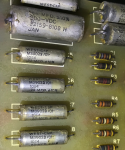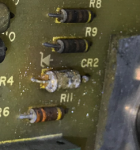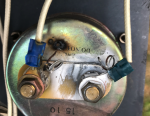- 18,136
- 27,237
- 113
- Location
- Burgkunstadt, Germany
J4 is the plug. J4-B is the plug number and pin letter in that plug. If you look real close at them, you will see tiny little letters next to the pins.I'm looking at the schematic you posted. I also pulled it down from both the 003 and the 002 -34 manuals. (yes, I'm learning allot!). Looking at the circuit from the Fuel Tank Float Switch (S3) going right I have a few questions:
the ">>" or "<<" labeled as J4-B or J5-B, are connectors such as the "canon plug" Guyfang noted, and the "P63A16" is the wiring harness part number?
Also, if I follow the circuit just before CR3, I see TB4-11. I'm having a hard time figuring out what that is. I am thinking it is the Fuel Pump Capacitor. But with that, I'm also lost to where/what the Diode (CR3) is.
Thanks to all.
P63A16 is a Wire number. Each wire has its own number. Ignore the last two numbers. That tells you the gage of the wire. So you only really need P63A.
TB means Terminal Board. It's a long, (or short) strip of terminals, where you hook up wires. If you open the control panel door and look in, you should see TB4. TB4-11 is the terminal board and the 11 means the 11th connection. There will be numbers printed above or below the TB, to help you find it. Normally read from left to right, or from top to bottom.
If i remember right, the CR3 is mounted directly on the TB. I am using a phone to do this and can't look at my TM's. The CR3 is needed to keep the K4 from being energized from back feeding of voltage.
Last edited:








